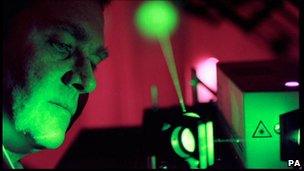Scientists build the world's first anti-laser
- Published

Traditional lasers rely on gain mediums to produce beams of coherent light
Physicists have built the world's first device that can cancel out a laser beam - a so-called anti-laser.
The device, created by a team from Yale University, is capable of absorbing an incoming laser beam entirely.
But this is not intended as a defence against high-power laser weapons, the researchers said.
Instead they think it could be used in next-generation supercomputers which will be built with components that use light rather than electrons.
Professor Douglas Stone, external and colleagues at Yale University had initially been developing a theory to explain which materials could be used as the basis of lasers.
Strange lasers
Recent advances in laser design have resulted in a number of unusual devices that do not fit the traditional concept of a laser, Professor Stone explained.
"So we were working on a theory that could predict what could be used to form a laser," he said.
That theory also predicted that instead of amplifying light into coherent pulses, as a laser does, it should be possible to create a device that absorbs laser light hitting it, said Professor Stone - an anti-laser.
They have now succeeded in building one.
Their device focuses two lasers beams of a specific frequency into a specially designed optical cavity made from silicon, which traps the incoming beams of light and forces them to bounce around until all their energy is dissipated.
In a paper published in the journal Science they demonstrated that the anti-laser could adsorb 99.4 per cent of incoming light, for a specific wavelength.
Light speed
Altering the wavelength of the incoming light means that the anti-laser can effectively be turned on and off - and that could be used in optical switches, Professor Stone told BBC News.
The anti-laser could turn out to be more useful in computing than weapon defence
Building something which can absorb light over a wide range of wavelengths is pretty simple, said Professor Stone, but only doing so for a particular wavelength makes the anti-laser potentially useful in optical computing.
The anti-laser's big advantage is that it is built using silicon, which is already widely used in computing.
It would not, however, be much use as a laser shield, according to Professor Stone.
"The energy gets dissipated as heat. So if someone sets a laser on you with enough power to fry you, the anti-laser won't stop you from frying," he said.
- Published7 June 2010